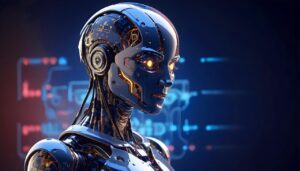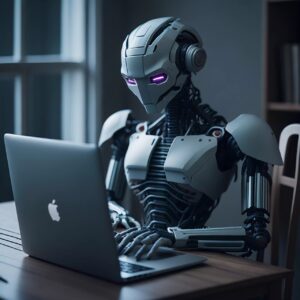“Artificial Intelligence”– This specific term has a dated history. Remember when we used to hear on television or even popular movies that AI would take our lives!
Well, this is however a misleading representation of artificial intelligence, but AI has significantly impacted our lives.
In addition to the downsides of AI such as reducing repetitive work, needing fewer workers, etc., there are many other pros that people should know like:
· AI may make transportation systems more efficient
· No need for human labor over many hours
· It is easy to automate boring work
· Artificial intelligence now enables organizations to operate effectively and take enhanced timely decisions with the help of AI software.
· Customer service experience has reached new heights with the help of artificial intelligence
With this information on what is good and bad about AI, we will now explore what AI is and the different forms available today!
What Exactly is Artificial Intelligence?
In simple terms: Artificial Intelligence is a modern computer that has the capability to simulate human thinking and learning capacities. There are numerous types of AI models available today– but all fall under 2 general categories:
a. Narrow AI: Also known as a “weak AI”, these types of AI systems are generally used for routine and repetitive tasks. Ex: Digital assistants
b. General AI: This is a more “strong” form of artificial intelligence. General AI systems or programs usually require human collaborations or even maintenance from time to time. However, this form of AI does not exist currently!
However, “Narrow” and “General” are very vague forms of AI classification. So, in the real world, we can classify artificial intelligence into 4 common categories.
4 Common AI Types
Beyond classifications such as “weak” and “strong”, AI systems are categorized into 4 common types. These include:
a. Reactive Machines: These are the simplest form of AI machines. These complex systems will react in the same way every single time a task/challenge is put in front of them. They have very limited functionality but their performance is extremely reliable. Ex: IBM’s chess playing computer Deep Blue
b. Limited Memory: As the name suggests, these types of systems can recall information contexts and respond accordingly. However, Limited Memory AI systems do require human feedback to train them. Ex: Automated customer support chatbots
c. Theory of Mind: These types of AI systems don’t exist in today’s world. They are purely theoretical. However, Theory of Mind AI’s, if invented, will have the capability to understand human emotions like urgency, anger, etc., and will be able to respond accordingly.
d. Self-Awareness: Self-Awareness AI systems are all talks of the distant future. These artificial intelligence systems would be derived from the Theory of Mind systems. These would be self-aware and have human-level consciousness and adaptability to complex situations!
Now, let’s understand the complete timeline of AI evolution. However, before that, we need to know when and who invented AI!
Who Invented AI?

Image source: pixabay.com
Alan Turing, the man behind the famous “Turing Test,” is renowned as the “father of AI”. This is because of a test he set up in the 1950s that had complex questions which showed machines could think like humans– or at least appear to do so!
Although John McCarthy came up with the term ‘artificial intelligence,’ for it’s believed he did so first at Dartmouth College in summer 1956 during a research project there.
The expression was later popularized by DARPA (Defence Advanced Research Projects Agency). DARPA released a project to map streets of several famous US cities to get a real life feel of the city!
The Timeline of Artificial Intelligence Evolution
Here’s a timeline of how AI systems became popular over the years:
a. In the 1950s, Alan Turing came up with the Turing Test which demonstrated that machines could exhibit human-like problem-solving abilities. He explained this test in his research paper “Computing Machinery and Intelligence”. It was also in this decade that John McCarthy introduced the term artificial intelligence and went ahead to come up with the Lisp programming language, which is still applied in AI today!
b. The first industrial robots were introduced into General Motors’ factories during the 1960s; while a computer program that can chat with people in English called ELIZA came about too.
c. Japan made the initial anthropomorphic robot with visual, locomotive, and verbal abilities in the 1970s. On top of that, there was an invention of a bacteria identification system at Stanford University.
d. Mercedes-Benz put on the market its pioneer driver-less automobile in the 1980s which has become the foundation for the development of such cars till the present day! Apart from that, there was also the emergence of a contemporary chatbot technology known as Jabberwacky.
e. During the nineties era, IBM introduced to the market Deep Blue, an artificial intelligence-based chess machine that managed to defeat Garry Kasparov, who at that time was still reigning as World Champion. It was also at this time when Google came up with its very first search engine indexing twenty-six million web pages.
f. The turn of the century witnessed expansion in Google’s web index to reach one billion pages and the creation of various other new AI robots like ASIMO (Honda) as well as Kismet (MIT).
g. In the 2010s, IBM came up with Watson, a computer system for natural language processing, which outperformed two ex-champions in “Jeopardy”– a popular American TV quiz show.
The Future of AI

Image source: pixabay.com
In the future, artificial intelligence will be part of our everyday experience. This will help us get through mundane and even more complicated tasks easily.
However, the current stage of AI is pretty nascent and it still needs a high level of development to impact major sectors such as healthcare, transportation and retail.
AI has the potential to entirely diagnose and even treat complex medical emergencies without the need of a professional doctor. This will help make the healthcare sector more accessible and efficient.
Transportation is already making a shift towards AI through driverless trucks and cars. With the increase in driverless vehicle options, road accidents would be greatly minimized and the transportation system could be made more efficient!
Another sector where we can see an increase of AI implementation is retail. These changes will occur through automated warehouses where AI inventory management systems would reduce the stress from already overwhelmed human workers.
The Bottom Line
The future of artificial intelligence lies in driverless cars, chatbots, medibots and more. This will help create more opportunities for people as well as give them a degree of freedom by reducing their mundane work!





